Server Virtualization with Windows Server Hyper-V and System Center v7.2
Question 1
A company has Active Directory Domain Services (AD DS) domain controllers that run
Windows Server 2012 R2.
You prepare a disaster recovery plan for Active Directory. You have the following requirements:
-> The domain controller restore process must complete as quickly as possible.
-> After the restore process completes, the Active Directory database on the domain controller must be brought up to date by using replication.
You need to implement the disaster recovery plan.
What should you do?
- A. Authoritatively restore the domain controllers by using the ntdsutil.exe tool.
- B. Restore the domain controllers by using the Active Directory Recycle Bin.
- C. Back up and restore the domain controllers by using the wbadmin.exe tool.
- D. Back up and restore the domain controllers by using the Idp.exe tool.
Answer : C
Explanation:
Ref: http://technet.microsoft.com/en-us/magazine/dd767786.aspx wbadmin: Enables you to back up and restore your operating system, volumes, files, folders, and applications from a command prompt. http://technet.microsoft.com/en-us/library/cc754015.aspx ntdsutil: Ntdsutil.exe is a command-line tool that provides management facilities for Active
Directory Domain Services (AD DS) and Active Directory Lightweight Directory Services
(AD LDS).
You can use the ntdsutil commands to perform database maintenance of AD DS, manage and control single master operations, and remove metadata left behind by domain controllers that were removed from the network without being properly uninstalled.
This tool is intended for use by experienced administrators.
http://technet.microsoft.com/en-us/library/cc753343.aspx
Active Directory Recycle Bin: Active Directory Recycle Bin helps minimize directory service downtime by enhancing your ability to preserve and restore accidentally deleted Active
Directory objects without restoring Active Directory data from backups, restarting Active
Directory Domain Services (AD DS), or rebooting domain controllers. http://technet.microsoft.com/en-us/library/dd392261%28v=ws.10%29.aspx ldp: This GUI tool is a Lightweight Directory Access Protocol (LDAP) client that allows users to perform operations (such as connect, bind, search, modify, add, delete) against any LDAP-compatible directory, such as Active Directory.
LDP is used to view objects stored in Active Directory along with their metadata, such as security descriptors and replication metadata. http://technet.microsoft.com/en-us/library/cc772839%28v=ws.10%29.aspx
Question 2
You have a Windows Server 2012 R2 server that has the Hyper-V role installed. The company has the following requirements for the Hyper-V host server:
-> Virtual machines (VMs) must only communicate with other VMs.
-> You must be able to monitor all TCP/IP packets to and from VMs from the moment that VMs are able to communicate.
-> You must support a third-party program that uses the Network Driver Interface
Specification (NDIS) API to monitor the TCP/IP packets between VMs.
You need to configure the environment.
Which three actions should you perform in sequence? To answer, move the appropriate actions from the list of actions to the answer area and arrange them in the correct order.
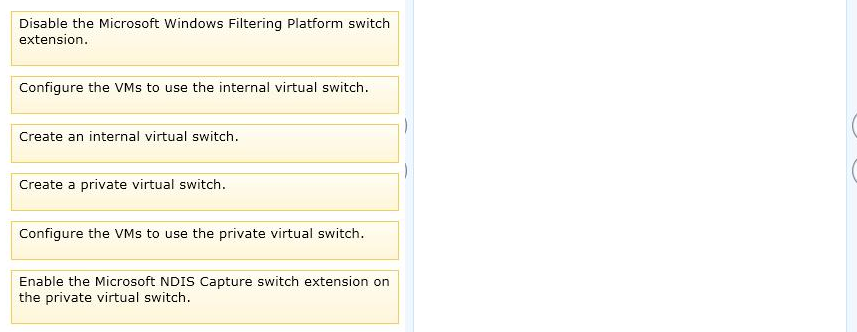
Answer : 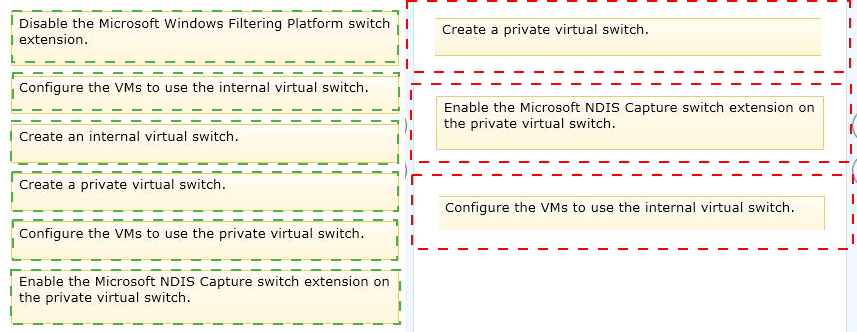
Explanation:
Box 1: Create a private virtual switch
Box 2: Enable the Microsoft NDIS Capture switch extension on the private virtual switch.
Box 3: Configure the VMs to use the private virtual switch.
Note:
Hyper-V Extensible Switch -
The Hyper-V extensible switch supports an interface that allows instances of NDIS filter drivers (known as extensible switch extensions) to bind within the extensible switch driver stack. After they are bound and enabled, extensions can monitor, modify, and forward packets to extensible switch ports. This also allows extensions to reject, redirect, or originate packets to ports that are used by the Hyper-V partitions.
Ref: http://technet.microsoft.com/en-us/library/hh831823.aspx
Question 3
You are the virtualization administrator for an organization. You manage a virtual machine
(VM) by using System Center 2012 R2 Virtual Machine Manager. The VM is in a running state. You plan to use the System Preparation (Sysprep) tool to create a virtual machine template from the VM.
You need to save a copy of the VM before you run the Sysprep tool.
Which actions should you take? To answer, drag the appropriate actions to the correct locations in the answer area. Each action may be used once, more than once, or not at all.
You may need to drag the split bar between panes or scroll to view content.

Answer : 
Explanation:

[7]
Note:
You must shut down the VM before cloning it.
Question 4
A company plans to create a Hyper-V test environment that will contain three virtual machines (VMs). The VMs are projected to grow 1 GB in size each day. The VMs will be configured as follows:

You must minimize the required amount of storage space by using the least amount of administrative effort.
You need to recommend a storage solution.
Which type of virtual disk type should you configure for each VM?
- A. differencing
- B. dynamically expanding
- C. fixed
- D. pass-through
Answer : B
Explanation:
http://www.petri.co.il/choosing-hyper-v-storage-virtual-hard-disks-2.htm http://searchservervirtualization.techtarget.com/tip/Fixed-vs-dynamic-disks-for-Hyper-V- virtual-machines
Question 5
An organization uses System Center 2012 R2 Data Protection Manager (DPM).
Backups of virtual machines that are hosted on local volumes complete successfully.
Backups of virtual machines that are hosted on storage area network (SAN) volumes fail.
You receive the following error message in the Windows Event Log:
Backup failed with the following error
An error occurred:
Writer 'Microsoft Hyper-V VSS Writer' reported an error: 'VSS_WS_FAILED_AT_FREEZE'.
Check the application component to verify it is in a valid state for the operation.
You need to ensure that all backups can complete successfully.
What should you do?
- A. On the Cluster Shared Volume (CSV), grant administrator rights to the DPM server computer account.
- B. On all Windows servers in the environment, enable the Volume Shadow Copy Service (VSS).
- C. Install and configure the Volume Shadow Copy Service (VSS) hardware provider from the SAN vendor.
- D. On virtual machine files hosted on the Cluster Shared Volume (CSV), grant administrator rights to the DPM server computer account.
Answer : C
Explanation: Ref: http://technet.microsoft.com/en-us/library/hh758184.aspx
Question 6
You use System Center 2012 R2 Operations Manager to monitor the datacenter infrastructure and applications for an organization. You import the SQL Server
Management Pack.
You are unable to monitor long-running SQL Server Agent jobs. You observe that the SQL
Server Agent Jobs View displays zero instances. Other SQL Server-related monitoring operations function as expected.
You need to monitor long-running SQL Server Agent jobs.
What should you do?
- A. Enable the Job Duration unit monitor.
- B. Enable agent proxy for SQL Servers.
- C. Enable the object discovery for the SQL Server Agent Job class.
- D. End maintenance mode for the SQL Server 2012 Computers group.
Answer : C
Explanation:
http://blogs.technet.com/b/kevinholman/archive/2011/08/05/how-to-monitor-sql-agent-jobs- using-the-sqlmanagement-pack-and-opsmgr.aspx
Ref: http://www.toolzz.com/?p=162
Question 7
An organization has two teams of developers. One team develops web applications. The other team develops mobile applications.
You administer servers for the organization. All four servers run Windows Server 2012 R2 and are part of a Hyper-V cluster. You create six virtual machines (VMs) for each team.
You plan to create a virtual environment for the teams. You have the following requirements:
-> Both teams must use the 10.10.10.0/24 subnet.
-> Each VM for the web application team must have network connectivity with all other web application VMs.
-> Each VM for the mobile application team must have network connectivity with all other mobile application VMs.
-> The VMs for the web application team must NOT connect to the VMs for the mobile application team.
You need to create the network for the VMs.
What should you do?
- A. Configure one connected network. Allow new VM networks created on this logical network to use network virtualization.
- B. Set the virtual LAN ID for the management network.
- C. Enable private virtual LAN (PVLAN) networks.
- D. Configure one connected network. Do NOT allow new VM networks created on this logical network to use network virtualization.
Answer : C
Explanation:
http://blogs.technet.com/b/scvmm/archive/2013/06/04/logical-networks-part-iv-pvlan- isolation.aspx
Download chart from: http://www.microsoft.com/en-us/download/details.aspx?id=37137
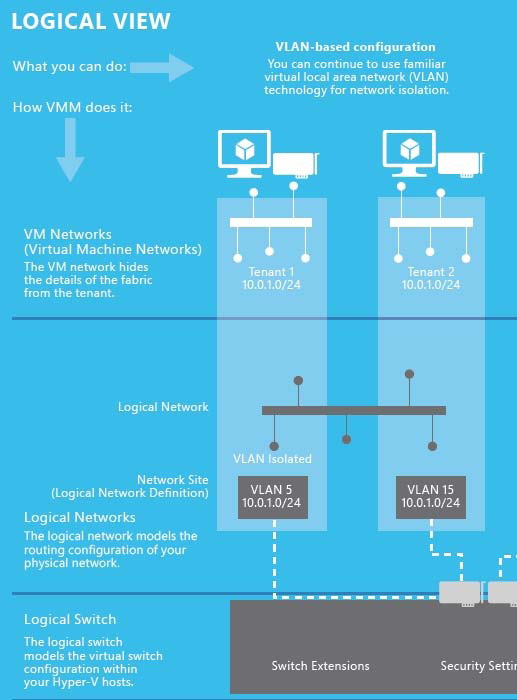
C:\Documents and Settings\Adnan Hameed\Desktop\untitled.PNG
Question 8
A software company has a Windows Server 2012 R2 server that has the Hyper-V role installed. The server hosts a single virtual machine (VM) named VM1. VM1 has one virtual
CPU, one virtual hard disk, and one virtual network interface card (NIC) that is attached to an external network.
The company prepares to test its software in VM1. Before testing begins, VM1 must meet the following requirements:
-> Availability of network bandwidth must be maximized.
-> VM network connectivity must be fault tolerant.
You need to configure the environment.
Which four actions should you perform in sequence? To answer, move the appropriate actions from the list of actions to the answer area and arrange them in the correct order.
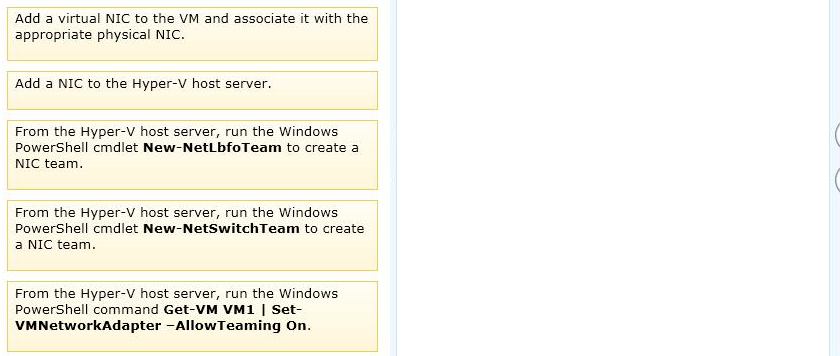
Answer : 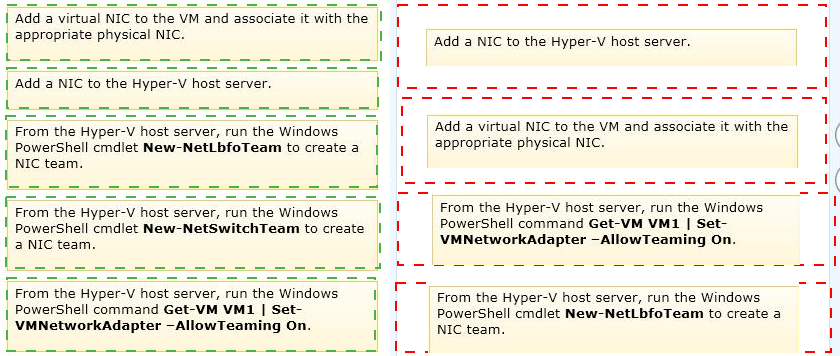
Explanation:
Box 1:

Box 2:

Box 3:

Box 4:

Note:
* Set-VMNetworkAdapter
The Set-VMNetworkAdapter cmdlet configures features of the virtual network adapter in a virtual machine or the management operating system.
/ parameter -AllowTeaming<OnOffState>
Specifies whether the virtual network adapter can be teamed with other network adapters connected to the same virtual switch. The value can be On (allowed) or Off (disallowed).
* New-NetLbfoTeam
The New-NetLbfoTeam cmdlet creates a new NIC team that consists of one or more network adapters. Teaming network adapters of different speeds is not supported. You can create a team with network adapters of different speeds, but the network traffic distribution algorithms do not take the speed of each network adapter into consideration when distributing traffic.
Incorrect:
* New-NetSwitchTeam
Creates a new switch team.
Question 9
You are the virtualization administrator for an organization. The organization uses all components of System Center 2012 R2 in its production environment.
You need to configure the environment to support Performance and Resource Optimization
(PRO).
How should you configure the environment? To answer, drag the appropriate server role to the correct location or locations. Each server role may be used once, more than once, or not at all. You may need to drag the split bar between panes or scroll to view content.
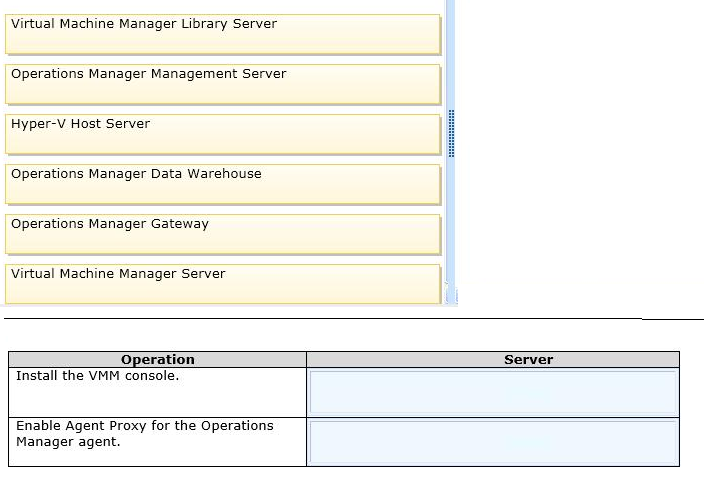
Answer : 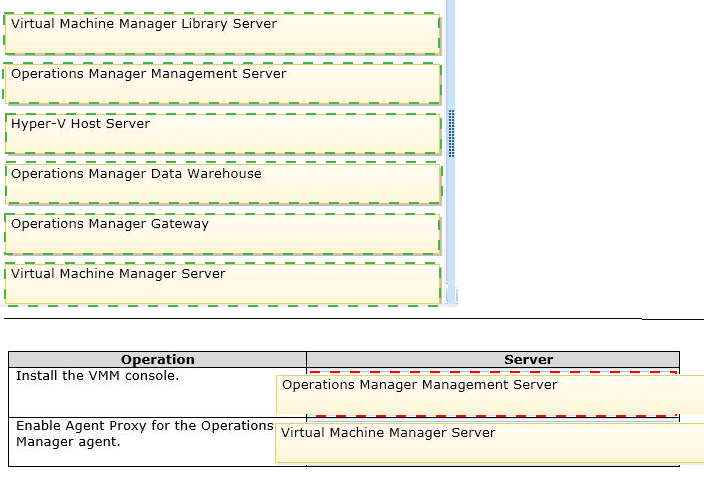
Explanation:

[7]
Ref: http://technet.microsoft.com/en-us/library/hh882396.aspx
Question 10
An organization has private and public cloud resources. The organization has Windows
Server 2012 R2 servers that have the Hyper-V role installed. You have one four-node cluster of Hyper-V host servers. You use System Center 2012 R2.
The virtual machines that run on the cluster must remain online when you install updates on the Hyper-V host servers.
You need to install updates on the Hyper-V host servers.
What should you do?
- A. Configure Windows Server Update Services (WSUS) to provide updates to the Hyper-V host servers in the cluster.
- B. Add all the virtual machines hosted on the cluster to a collection in System Center 2012 R2 Configuration Manager. Deploy updates to the collection.
- C. Use the Cluster-Aware Updating (CAU) wizard.
- D. Configure Windows Update on the Hyper-V host servers to download updates from Microsoft Update.
Answer : C
Explanation:
Ref: http://technet.microsoft.com/en-us/library/gg675084.aspx
CAU is an automated feature that enables you to update clustered servers with little or no loss of availability during the update process. During an Updating Run, CAU transparently performs the following tasks:
Puts each node of the cluster into node maintenance mode
Moves the clustered roles off the node
Installs the updates and any dependent updates
Performs a restart if necessary
Brings the node out of maintenance mode
Restores the clustered roles on the node
Moves to update the next node
For many clustered roles (formerly called clustered applications and services) in the cluster, the automatic update process triggers a planned failover, and it can cause a transient service interruption for connected clients. However, in the case of continuously available workloads such as Hyper-V with live migration or file server with SMB
Transparent Failover, CAU can coordinate cluster updates with no impact to the service availability.
Note -
The CAU feature is only compatible with Windows Server 2012 R2 and Windows Server
2012 failover clusters and the clustered roles that are supported on those versions.
Question 11
You administer the Hyper-V environment for a company. All virtual machines must use dynamic memory and virtual non-uniform memory access (NUMA) settings that are aligned to the underlying hardware.
One virtual machine is misconfigured.
You need to update the misconfigured virtual machine.
In the Settings dialog box for the virtual machine, which two options should you select?
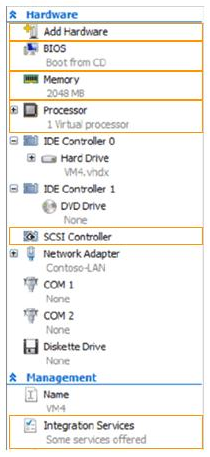
Answer : 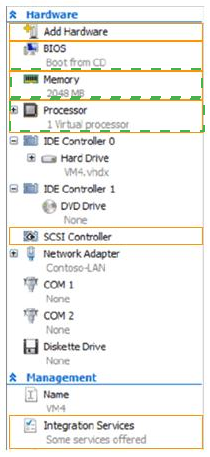
Explanation:
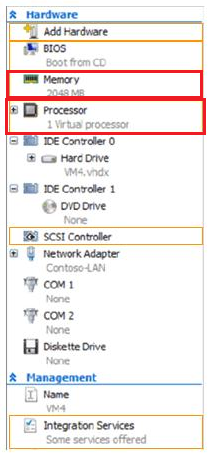
[7]

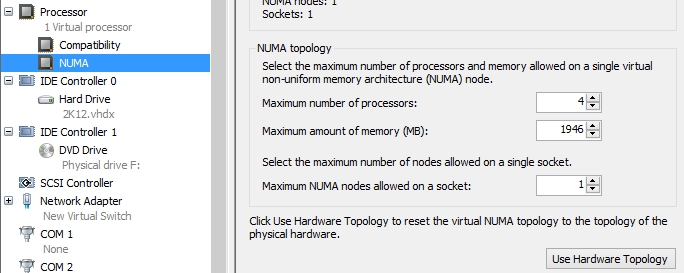
Question 12
You administer a server that runs Windows Server 2012 R2 that has the Hyper-V role installed. You plan to apply an update to a virtual machine (VM). You have the following requirements:
-> You must be able to quickly revert back to a pre-update state.
-> The solution must minimize storage requirements on the server.
You need to apply the update. What should you do?
- A. Run the Windows PowerShell cmdlet New-VirtualDiskClone.
- B. Create a checkpoint of the VM.
- C. Run the Windows PowerShell cmdlet Export-VMSnapshot.
- D. Export the VM.
Answer : B
Explanation:
Ref: http://technet.microsoft.com/en-us/library/cc956044.aspx
Question 13
You administer two Windows 2012 R2 servers named SERVER1 and SERVER2. Both servers have the Hyper-V role installed. SERVER1 has network adapters that have
Remote Direct Memory Access (RDMA) enabled. You plan to implement live migration in the environment.
You have the following requirements:
-> Use remote management tools to manage the live migration tasks.
-> Optimize network performance during live migration.
You need to configure live migration settings on each host server.
In the Live Migrations section of the Hyper-V Settings window, which two options should you select? To answer, select the appropriate option buttons in the dialog box in the answer area.
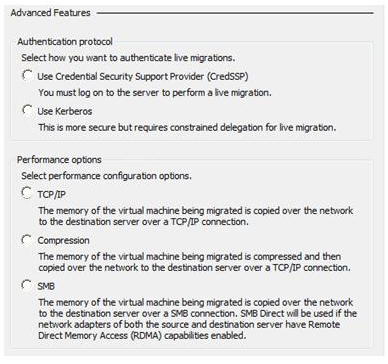
Answer : 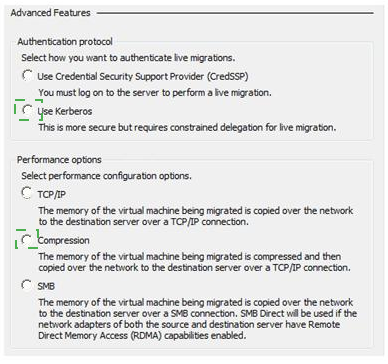
Explanation:
[7]
Question 14
You administer a Windows Server 2012 R2 Hyper-V host server that contains production and test virtual machines (VMs). You plan to optimize the performance of the VMs.
The following settings must be applied to the VMs:
-> You must set a maximum value for the input/output operations per second (IOPS) on the test VMs.
-> You must set a minimum value for the IOPS on the production VMs.
You need to configure the environment. What should you do?
- A. On all VMs, enable Network Quality of Service (QoS).
- B. Create a shared virtual hard disk (VHD).
- C. On the Hyper-V host server, enable Resource Metering.
- D. On all VMs, enable Storage Quality of Service (QoS).
Answer : D
Explanation: Ref: http://technet.microsoft.com/en-us/library/dn282281.aspx
Question 15
A company has a Windows Server 2012 R2 server that has the Hyper-V role installed. The server hosts 12 virtual machines (VMs) that run Windows Server 2012 R2. The company plans to deploy System Center 2012 R2 Data Protection Manager (DPM).
The company has identified the following requirements for the DPM deployment:
-> allow files and folders on VMs to be recovered
-> allow recovery of data to a network share
-> minimize the number of DPM protection agents that you must deploy
You need to implement the backup solution.
Which two actions should you perform? Each correct answer presents part of the solution.
- A. Deploy a DPM server.
- B. Deploy the DPM protection agent to VMs.
- C. Add the Hyper-V role to the DPM server.
- D. Configure DPM to perform guest-level backups of the VMs.
- E. Configure DPM to perform host-level backups of the VMs.
Answer : AC
Explanation: * DPM protection supports the following scenarios:
/ (this scenario) Protects virtual machines that are hosted on stand-alone servers that run
Hyper-V and that use local or directly attached storage.
/ Protects virtual machines that run on a cluster. The cluster uses Cluster Shared Volumes
(CSV) storage.
/Protects virtual machines that run on a stand-alone server or cluster and that use SMB 3.0 file server storage.
/Protects virtual machines that are running during a live migration.
* Example: Protection for virtual machines on a stand-alone server that is running Hyper-V
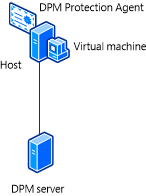
Hyper-V on Standalone -
This configuration protects one or more virtual machines on a stand-alone host computer.
Storage can be local on the host server, or directly attached to it, for example a hard drive, a storage area network (SAN) device, or a network attached storage (NAS) device.
Alternatively, the host server might use SMB 3.0 storage on an alternate file server. The
DPM protection agent must be installed on all hosts and on the file server if storage is hosted by using SMB 3.0.
Incorrect:
Not B: Would not minimize the number of Protection Agents.
Ref: https://social.technet.microsoft.com/wiki/contents/articles/17493.protecting-hyper-v- virtual-machines-with-system-center-dpm-2012.aspx